|
|
|
The Birth of the Roman Republic:
Heroes, Villains & Coins
First published April 19, 2010
at Hubpages.com
During the thousand, or so, years leading up to the mythical murder of
Remus by Romulus, Rome was a camp/settlement/village/town/city surrounded
by tribes, and city-states. To the north were the Etruscans; a sophisticated
society of city-states lead by a single person and consul. It is arguable
that Roman history is merely an Etruscan history that settled out from
a maelstrom of local and imported conflicts until each faction fused their
aspects into Etruscan society and dissolved into a Roman history.
If you operate from the perspective of a Roman history that began on April
21, 753 BC with the murder of Remus, as most people do, there were six
kings to follow Romulus before the Roman Republic was established. However,
ignoring the Etruscans regarding the establishment of the Republic would
be unfair. The last three Roman kings were Etruscan.
Although much of what the ancient Roman historians wrote of the Etruscans
was derogatory, they adopted many Etruscan ways. The purple trimmed robes,
the eagle atop a standard, the consul, gladiators fighting to the death,
use of the arch in construction, and the *fasces to mention just a few.
What they didn’t adopt from the Etruscans was a measurable degree of
equality for females, and a comfort with public displays of affection and
possible sex.
*
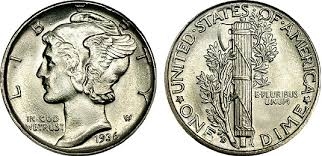
Wikipedia Commons
Fasces (Latin meaning 'bundle'), a bundle of reeds or sticks
often with an axe nestled in its center, is shown here on
the reverse of an American Mercury Dime.
In order to bridge the deadly fight between Romulus and Remus and the birth
of the Republic, I have listed the Roman Kings whose actions created a
desire for a republic, but more importantly influenced the mood, values,
beliefs, and ceremonies that Rome was developing at the time.
Seven Roman kings; no queens. They were not the nicest men, and they made
no coins I am aware of.
-
Romulus - first King of Rome from 753 - 715 BC
-
Numa Pompilius - was a Sabine; reputed to be a peaceful
ruler from (715-673 BC).
-
Tullius Hostilius - ruled from (672-641 BC).
-
Ancus Marcius - ruled from (640 - 616 BC).
-
Tarquinius Priscus, (Tarquinius I) - ruled from (616 -
579 BC).
-
Servius Tullius - ruled from (578 to 534 BC).
-
Tarquinius Superbus, (Tarquin the Proud) - ruled from
(534-510 BC).
Much of our understanding of ancient Roman history leading up to the Republic
comes from what remains of the writings of Titus Livius (59 BC – AD 17)
(Usually referred to as Livy), and the people at that time who read and
commented on his books.
According to Livy, the last Tarquinius was arrogant, vicious and lacked
favor with the aristocrats who made up the Senate. The senators vowed that
Rome would never again be ruled by a king. The truth of the matter was
more likely that this typical conduct of kings was not as important as
the senator’s desire to gain power.
The Roman Republic was formed in 509 BC when Lucius Junius Brutus, an Etruscan
nobleman, lead a revolt against Tarquinius Superbus that put the Senate
in control of Rome and ended the era of kings in Rome.
Considering names, take note of the names ‘Lucius Junius Brutus’ (Etruscan
nobleman and rebel) and that of ‘Marcus Junius Brutus’ (Senator of
‘et tu Brutus’ fame) involved in the assassination of Julius Caesar
465 years later. The birth and death of the Roman Republic was instrumentally
effected by a pair of bookend Bruti.
It is common through history that powerful people try to connect themselves
with the powerful, influential; even the divine. The Emperors of Japan
were conveniently proven to be the direct descendants of the gods through
the text of the Kojiki (Books they ordered written), and the leaders of
the Roman Senate were no less megalomaniac. Julius Caesar fancied himself
a descendant of the god Venus. Each Roman house had a god that protected
it; occasionally a god with family ties. The importance of aristocratic
ancestry and familial ties, another Etruscan infusion, mattered a great
deal. Aristocracy didn’t guarantee power and wealth, but it did make
it much more possible, and to have history and a god or two on your side
might help.
If you were a young son of a senator, or patrician aristocrat, you might
become one of three magistrates that produced coins. The position was significant.
The coins they were allowed to produce would often publicize a family connection
with important historical people and events; as well as with the gods.
The Romans created a very real economy in controlling and producing graphic
advertisement and propaganda, and their longest lasting media were their
coins.
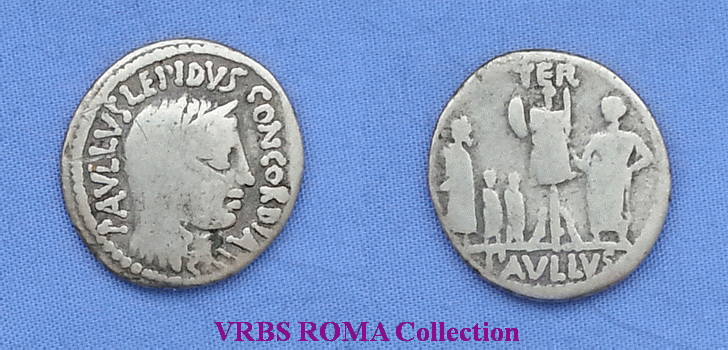
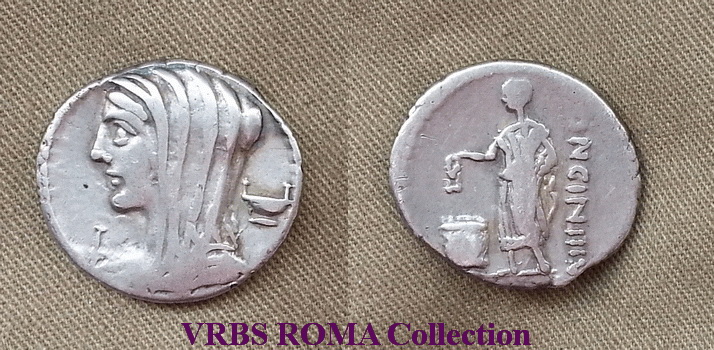
The coin above, top coin, was produced in 62 BC by Aemilius Lepidus Paullus
(Brother of the Second Triumvir Lepidus who ruled with the better known
Mark Antony and Octavian (later know as the first Emperor Augustus).
This coin is a fine example of propaganda in which the Aemilius Lepidus
family is boasting of their relation to the great Roman general Lucius
Aemilius Paullus who ended the Third Macedonian War (171-168 BC) and captured
the Macedonian King Perseus. The reverse of this denarius shows the
Macedonian king on the right bound as a prisoner along with his half-brother
Philippus and son Alexander. At the bottom, in exergue, is the name
of this family member: PAVLLVS. The obverse of the coin connects
‘PAVLLVS LEPIDVS’ with the god ‘CONCORDIA’. Subtlety was not a
Roman trait.
The bottom coin was minted by was minted by Moneyer L. Cassius Longinus
in 60 BC. He was a relative of the infamous Gaius Cassius Longinus who
was instrumental in developing and participating in the plan to assassinate
of Julius Caesar 16 years later.
I find the Lepidus family to be one of the more interesting families in
power during the establishment of the Roman Republic and then that of Imperial
Rome. They are often mentioned, but seldom centered upon. They
never got the ‘ink’ that Julius Caesar, Brutus, Augustus, Mark Antony,
Cassius, and the like received, but they were there, they were mentioned,
and they were significant. They swam at the deepest end of the power
pool in Rome. Marcus Aemilius Lepidus along with Mark Antony and
Augustus formed the Second Triumvirate. These three went after the
assassins, revenged Caesar’s death, and then went at each other.
Lepidus did nothing extremely wonderful as triumvirate. He gave up
his power easily when instructed, then retired, and died of old age.
Wielding power in Rome and managing to retire and die of old age was a
very uncommon and significant accomplishment.
Two other important coin producers and history makers were Lucius Cornelius
Sulla 138 BC – 78 BC, and Gnaeus Pompeius Magnus 106 BC - 48 BC.
Sulla gave momentum to the erosion of the republic when he became dictator;
this followed two terms as consul. He invaded Rome twice. Gnaeus
Pompeius Magnus (Pompey the Great) did his part as a powerful dictator
and member of the First Triumvirate along with Marcus Licinius Crassus
and Gaius Julius Caesar.
Now let’s go to the later Brutus, whose namesake gave rise to the roman
Republic, played an important role in the ending of that Republic. And
Cassius, with whom Brutus conspired along with others, was the firebrand
that lobbied strongest for the muder of Julius Caesar; that is if we are
to believe Shakespeare, and many others.
Although Sulla and Pompey the Great added to the momentum that a king-like
ruler of Rome might bring to the end of a Republic, it was the conspiracy
by Cassius, Brutus, and team to assassinate Julius Caesar that finally
brought the curtain down on the Republic.
It is believed that Caesar was assassinated beneath a statue of Pompey.
When Caesar was stabbed 23 times, the plot that was created by Gaius Cassius
Longinus and Marcus Junius Brutus hatched. It happened on March 15,
44 BC; ‘The Ides of March’. Both Cassius and Brutus were moneyers
and produced coins. Brutus produced a coin that associated the assassination
of Julius Caesar with freedom from slavery. Imagine: Aristocratic
slaves no less.
On 26 November 43 BC the forming of the Second Triumvirate marked the end
of the Roman Republic. The Second Triumvirate was made up of Lepidus,
Octavius (Augustus), and Marcus Antonius (Mark Antony).
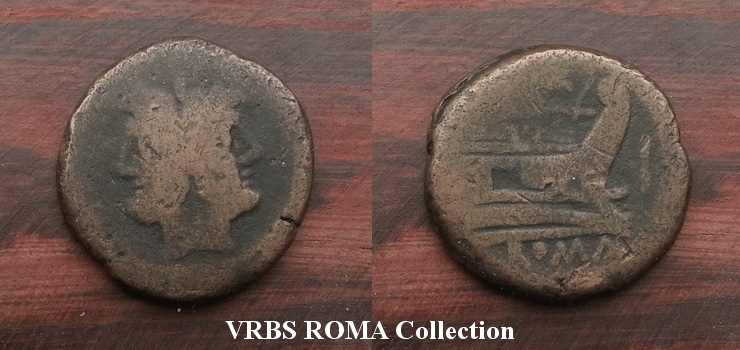
(33mm, 26.4 grms)
Roman Republican, Anonymous As. 189-180 BC.
Obverse: Laureate head of Janus;
I above
Reverse: Prow of galley right with I
before;
Victory and spearhead above, ROMA below.
Crawford 145/1; Sydenham 293; BMCRR 497; Sear 676
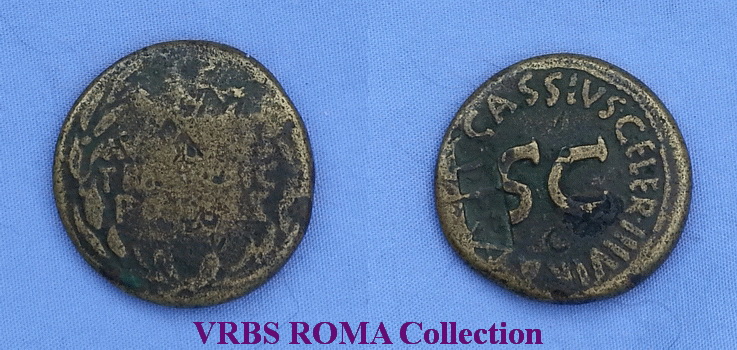
Bronze dupondius produced by Gaius Cassius Celer, Magistrate
in charge of preparing the dies and striking gold, silver and bronze coins
under the rule of Augustus in 16 BC.
|
|
Articles
By: Anthony Ballatore
Roman Emperors & their Coins
0)
Ancient Roman Coins On Ebay
1)
When, where & why were coins first made?
2)
The Story of Romulus and Remus & The Birth of Rome
3)
The Roman Republic
4)
Julius Caesar and the Death of the Republic
5)
Augustus Caesar: The First Roman Emperor
6)
Tiberius Caesar: The First Julio-Claudian Heir
7)
Caligula: The first really crazy Caesar
8) Claudius: A level headed Caesar?
9) Nero: The Last Julio-Claudian Heir
|
|
Websites worth knowing:
WildWinds.com
By far the single best location for identifying, evaluating, and touring
ancient coins. This link will direct you to their seach engines. Enjoy.
ForumAncientCoins.com
Along with WildWinds, this is a site of the highest regard, accurate
information, and ethical policies; 'AUTHENTICITY GUARANTEED FOR ETERNITY'
says it all.
FSRCoins.com
Frank S. Robinson is a unique individual. I have more respect for Mr.
Robinson than any other coin dealer. His book 'The Case for Rational
Optimism' (2009) will most likely leave you with this same perspective.
If his book doesn't, dealing with him will. He is often mistaken for Neil
Armstrong. :-)
Harlan
J. Berk, Ltd.
Located in Chicago, Harlan J. Berk, Ltd. is an excellent location for
both common and rare coins; often of
museum quality.
Rg.ancients.info
Reid Goldsborough's web pages are well written, educational, the first
site to read regarding counterfiet coins. This site is hosted for free
by VCoins.
VCoins.com
A commercial coin and information site established December 3, 1998.
Their code of ethics and years of operation speaks loudly.
DirtyOldCoins.com
Another commercial coin and information site.
ThePenAndQuill.com
One of our sites dedicated to pens, ink, quills, books, writing, reading,
history, and anything else that envolves language, art, and ideas.
|
And
where was the firebrand Mark Antony during all of this history?
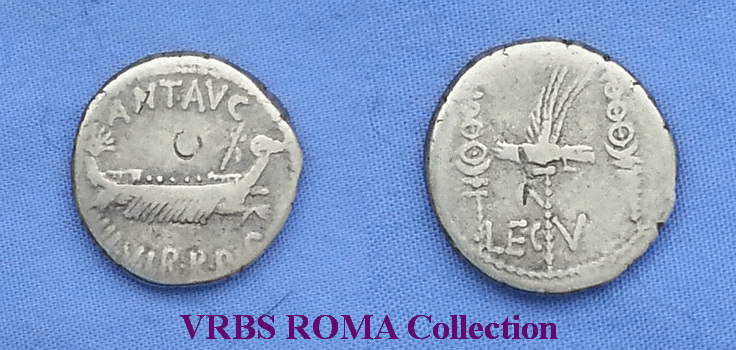
(17mm 3.44grms)
MARK ANTONY. 32 BC. AR Legionary Denarius
Obverse: ANT AVG. III VIR. R. P. C, galley to
the right
Reverse: LEG V, aquila and two legionary standards
Crawford 544/18; Sear, CRI 354; Sydenham 1221; RSC 32
Here is an example of a legionary coin produced by Mark Antony for his
Fifth Legion ‘LEG V’. Mark Antony’s (ANT) legionary coins were
used throughout Rome and the Mediterranean. They are a fairly common
coins, but often expensive when in good and readable condition. They
are often very worn and difficult to read because they were produced of
a low quality silver. If, in the ancient Roman marketplace, a person
had to spend a coin, they would choose to spend the low silver content
coins and keep the one with higher silver content.
As far as Mark Antony is concerned, he will be saved for a page of his
own. His anger at the death of his friend, Julius Caesar, and his
revenge brought him ruin. In as much as revenge is one of human's
baser drives, Antony was consumed by his baser drives; as history has shown.
To close my short history of the Roman Republic, and coins to prove it,
I would like to encourage you to try something I find very entertaining:
Connecting the famous individuals during this time and place in history
with coins, books, and videos. When I watch the BBC production of ‘I
Claudius’, or the HBO production of ‘Rome’, I take great pleasure
in familiarizing myself with the family trees of the individuals involved,
searching for coins depicting or issued by these characters at WildWinds.com,
searching with Google to learn more, and, if I have them, holding coins
that were actually designed and/or issued by these, sometimes bizarre,
but always interesting individuals. Coins by Claudius I are common and
not all that expensive if you don’t mind having a coin that has felt,
and shows the effects of time.
Good examples of such coins for the show ‘I Claudius’ are shown below.
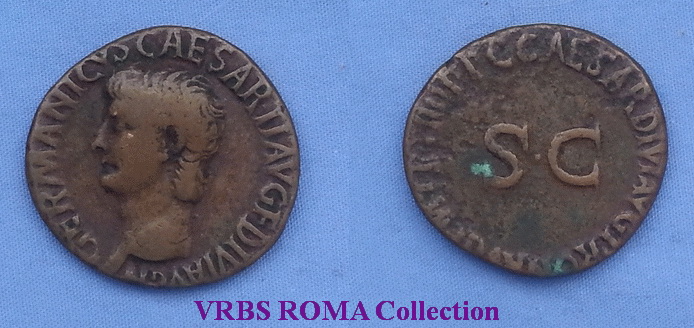
(26/28mm 8.76grms)
Germanicus Æ As.
Obverse: GERMANICVS CAESAR TI AVG F DIVI AVG
N, bare head left
Reverse: C CAESAR DIVI AVG PRON AVG P M TR
P IIII P P around SC
BMC. 74 Cohen 4
Struck under Caligula, 39-40 AD.
This coin was minted under the rule of Caligula. It shows the profile of
Germanicus who died in 19 A.D. Germanicus was the nephew of Tiberius, and
Caligula’s father. Caligula was the third Emperor of Rome and a very
sick and infamous individual; in the BBC production ‘I Claudius’ he
is complicit in the murder of his father Germanicus. He is reputed to have
appointed a horse (Incitatus) to the senate, coercively pimped the wives
of the senators at his orgies, battled with the god Neptune over sea shells,
and died believing he was a god himself.
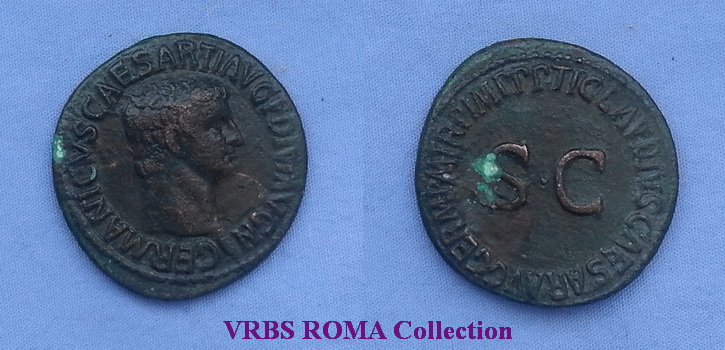
(28/30mm 9.63grms)
Germanicus, As
Obverse: GERMANICVS CAESAR TI AVG F DIVI AVG
N, bare head of Germanicus, facing right
Reverse: TI CLAVDIVS CAESAR AVG GERM P M TR
P IMP P P, around a large S C
RCV 1905, RIC 106
Issued 42 A.D., by Claudius, in honor of his deceased
brother.
This coin also shows the profile of Germanicus, but was issued by Claudius,
Caligula’s uncle.
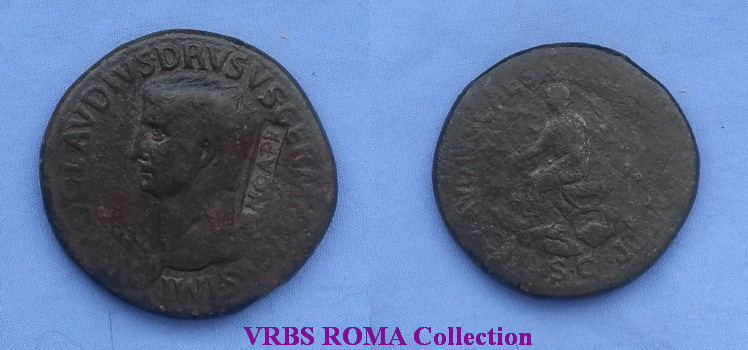
(36.5/35mm 28.16grms)
Nero Claudius Drusus AE Sestertius
Obverse: NERO CLAVDIVS DRVSVS GERMANICVS IMP,
bare head left
Reverse: TI CLAVDIVS CAESAR AVG P M TR P IMP,
Claudius, togate, seated left on curule chair, holding branch; arms lying
around; SC in exergue.
RIC I 93 (Claudius); Cohen 8.
Nero Claudius Drusus died in 9 BC, was the brother
of Tiberius.
This coin was struck by Claudius during 41-42 AD.
This coin depicts Nero Claudius Drusus Germanicus the father of Claudius
I and his brother Germanicus Julius Caesar. It is the largest Roman
coin in the Vrbs Roma collection to this date.
In the video ‘I Claudius’, Livia, the wife of Augustus, is suspected
of having Germanicus senior killed to make way for Tiberius becoming emperor.
She is shown to have killed or had killed most of the imperial family and
friends; even her husband Augustus. Can you get more intrigue and perversion
than that? These people and their actions have been woven into the fabric
of the world we live in today. Look around. Rome is everywhere. Even today;
and even more so if today happens to fall on a day in any month of the
year. After all, it started with the Julian Calander.
For your consideration:
When reading Latin found on ancient Roman coins, keep
in mind that the 'J' did not exist, the 'I' stood in for it, and the 'V'
stood in for the 'U' and 'W'; hence Julius was spelled 'Ivlivs'.
-
January (Ianuarius) - The Roman god Janus. Janus
is the god with a head that faces left and right. It is looking at
the past and the future; saying bye to the old year, and hello to the new
year.
-
February (Februatio) The Roman festival of purification.
-
March (Martius) Named after Mars, the Roman god
of war.
-
April (Aprilis) April was sacred to Venus, the
Festum Veneris et Fortunae Virilis being held on April 1st . It is possible
that Aprilis was originally the month of Aphrodite. A connection from ‘Fool’
to ‘Love’ is not a difficult one for most of us to make.
-
May (Marius) Most likely referring to the Roman
goddess Bona Dea of fertility, healing, virginity and women, also known
as Marica.
-
June (Iunius), Honors the ancient Roman goddess
Juno, the wife of Jupiter.
-
July (Iulius) Originally named Quintilis by the
Romans as it was the fifth month at that time, it was renamed Julius in
honor of Julius Caesar, who was born in that month.
-
August (Augustus) Originally named Sextilis because
it was the sixth month of the Roman ten month calendar. It was changed
in 8 BC to Augustus in honor of the first emperor.
-
September (septimus) In Latin, septem means "seven"
and septimus means "seventh". September was the seventh month of the Roman
calendar until 153 BC.
-
October (Octo) October retains its Roman name for
“eighth”.
-
November (novem) November retains its Roman name
for nine as it was the ninth month of the Roman calendar.
December (decem) December retains its Roman
name and place as the last month of the year. This made more sense to the
Roman with a ten month calendar.
|
|
|